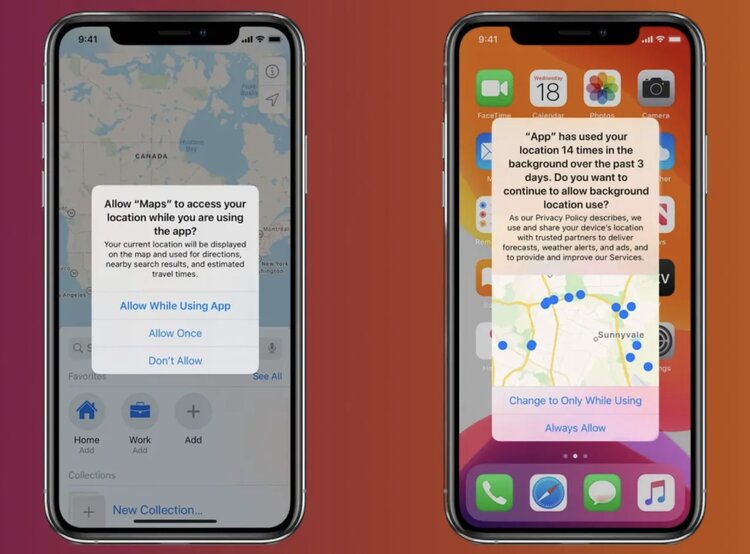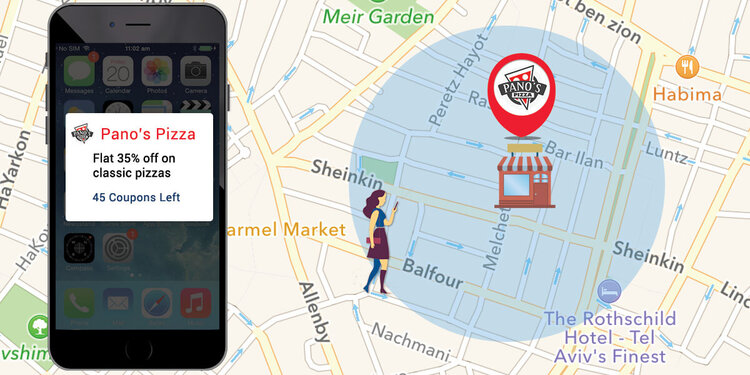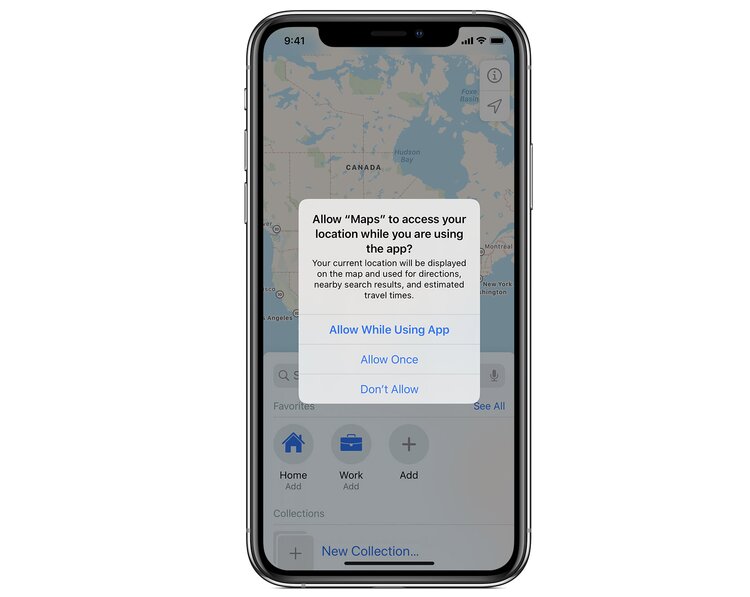In today’s world there’s an app for everything. From organizing your finances to ordering a pizza or even learning a new language. The average person has around 40 apps installed on their phone. And each of them asks for certain permissions required for functionality.
But which apps need location permissions? Why do they need it? And what access should you allow? While your IP address reveals your broad location, many apps need your precise location in order to perform their main functions.
Want to find out more? Then read on…

What are app permissions on iPhone & Android?
As the name suggests, app permissions are the permissions required by apps before they can access features on your device. On Android and iOS, permissions are required for every app on Google Play Store or Apple App Store, explaining what part of your phone the app requires access to. This can be anything, from your camera and photos to your contacts, calendar, location and more.
For example, you can allow a social networking app to access your camera so you can take and upload photos to that app. Or you can allow a messaging app to access your contacts so it can find any family and friends who are using the app.
Maps, navigation apps and other location-based apps all depend on knowing your location. An app also needs it if it uses location-based technology such as geofencing to trigger location-based notifications and experiences. These apps range across an array of industries, from retail and hospitality, to travel, HR, healthcare and more.
What app permissions should I allow?
Granting app permissions can be a sensitive subject. Some mobile users are worried about apps stealing their private data. The good news is that both the App Store and Google PlayStore are designed to be safe and trusted places for users to discover apps.
In order to submit new apps and app updates, developers need to adhere to strict guidelines and provide information about their app’s data collection practices. Developers are responsible for making sure everything in their apps complies with these guidelines, including ad networks, analytics services and third-party SDKs.
When deciding what permissions to allow, users are in full control of what data to share, and with whom. That said, it can be tricky deciding what app permissions you should allow. A good rule of thumb is to think about what the app needs to do and what parts of your phone it might need to access.
You should probably avoid granting app permissions that aren’t necessary for the app to work. For instance, if the app shouldn’t be accessing your camera, don’t allow it. Social media apps like Instagram will naturally request access to your camera and photos. And navigation apps like Waze will naturally need to know your location.
Another thing to think about is what’s in it for you. For instance, a voucher app might request access to your location so it can send you location-based notifications. The app wants permissions to perform these functions, and in return you have a great app that sends you personalized discounts and offers – all for free.

Should you allow apps to access your location?
If it’s a main function of the app and it improves user experience then yes, you can allow apps to access your location. Many experts agree that for the vast majority of people and the vast majority of circumstances, the benefits users get from sharing their location exceed the risks that might be out there.
That said, there are a number of steps you can take to protect your phone’s privacy and security. When downloading apps, we highly recommend that you only download apps from verified sources such as Apple App Store and Google Play Store. It’s also a good idea to give every app a thorough review before downloading it.
If you allow apps or websites to use your data or your current location, you’re subject to their terms, privacy policies and practices. You should review these to understand how they use your location and other information.
Also, remember there’s a big difference between granting all app permissions and granting location permission only. By granting all app permissions, an app can access all of those features on your phone. While granting location permission only allows an app to access your location information.
‘Always Allow’ location & notifications permissions
Apps with location-based capabilities need permission to send notifications and to use the location of your device. They will be limited a lot if you don’t grant ‘Always’ location permission along with permission to send notifications. The ‘When in Use’ permission allows for some functionality but it’s not enough if you want to make full use of the app when it’s not open on your screen.
How do I always allow location?
When the ‘Always’ permission is granted, you’ll never miss out on location-based notifications and real-time tips when you’re out and about. Don’t forget, the app will tell you why location is needed so you will see the benefits you’ll get in return.
If you grant an app ‘While In Use’ permission, the app may ask you for permission to use your location when it is in the background. This is because it can’t use your location unless you’re actively using the app. So, say you were using an airline app, it can’t send you notifications unless the app is open. If you scroll to another app, you could miss notifications, and even miss your flight!
In the following sections we’ll tell you how to always allow location permissions in iOS and Android
Android app permissions
You can allow Android apps to use a variety of features on your phone such as your contacts list, your calendar, your location and more. The app will send a notification asking for permission to use these features, which you can either allow or deny. You can also change app permissions on your Android phone for a single app or by permission type in your phone’s settings.
Android location permissions
On Android, you can let apps use your phone’s location to perform specific actions or give you information. For instance, apps can use your location to give you driving directions or help you find nearby businesses or services. Here are the options you can choose from:
- All the time: The app can use the permission at any time, even when you’re not using the app. Select this option to always allow location on Android apps.
- Allow only while using the app: The app can use the permission only when you’re actively using the app.
- Ask every time: Every time you open the app, it’ll ask you to use the permission.
- Don’t allow: The app can’t access the feature, even when you’re using the app.
Types of location apps can request:
- Approximate location: The app can determine your location within 3 square kilometers.
- Precise location: The app can access your phone’s exact location.
- In the foreground: The app can use your location only when the app is actually open on your screen.
- In the background: The app can use location info at any time, even if you aren’t using it.
iOS app permissions
Similarly to Android, you can allow iPhone apps to access a whole range of features on your phone such as your contacts, calendar, camera, location and more. The first time an app wants access you will receive a notification with an explanation. After you grant or deny access, you can modify access at any time by going to Settings > Privacy, then scrolling the list of apps where you can toggle their permissions accordingly.
iOS location permissions
When an iOS app tries to access your location it must ask for your permission, A notification will appear explaining which app is requesting the permission as well as the developer’s reason for requesting it. When you grant permission, Location Services allows apps to use information from mobile, Wi-Fi, GPS and Bluetooth to determine your approximate location.
Here are the options to choose from:
- Allow While Using App: An app is considered “in use” when you’re actively using it in the foreground, or when it is using location in the background, in which case a blue pill will be displayed in your status bar.
- Allow Once
- Don’t Allow

When an app asks for the “While Using App” permission first, it is still possible to upgrade this later to the “Always” permission when the app sends another request.
What apps should have location permission?
With the endless apps out there, it can be hard to know which apps need location permissions and why. While it might seem obvious why some apps need it, that’s not always the case.
Apps that need location permissions
Location sharing apps
Location sharing apps can be powerful and convenient tools, however you need to opt-in to share your location for them to work. Using location technology, these apps let you do things like keep track of your kids or share your real-time location with family and friends. For instance, with Apple’s Family Sharing, you can share your location with family members in the Find My app or Messages app.
Navigation apps
Navigation apps like Google Maps and Waze rely on users granting location permissions. In addition to performing its main functions, location sharing allows these apps to offer location-based notifications and experiences to users. For instance, you can use Waze for routing and directions, and also to find petrol, fuel prices and local deals and offers.
Social media apps
Social media apps like Facebook generally need location access for geotagging the photos you post. Many of them will also use your location data to send more targeted ads. If you enjoy these functions then it’s worth opting in to share your location. Don’t forget you can modify your permissions if you change your mind.
Retail & Restaurant apps
Retail and restaurant apps use location to let users know where they are and to personalize user experience. From welcome messages on arrival to location-based experiences that improve the shopping experience and strengthen customer loyalty. Users can enjoy personalized notifications about local deals, and make the most of things like curbside pickup, click & collect or mobile order drive-thru.
Voucher & cashback apps
Voucher and cashback apps use location to help you search the best deals nearby and get location-based rewards. For instance, the Vouchercloud app needs access to your location to show you the best offers for shops and restaurants near you, while the Shopkick app gives you rewards just for visiting your favorite stores.
Travel and transport apps
When you share your location with travel and transport apps you can access an array of helpful location-based features. From airport baggage belt arrival updates to automatic check in, service upgrades, travel updates and location-based notifications. In a rush? Location sharing makes it possible for transport apps to use smart ticketing for automatic ‘Be-in Be-out’ payments.
Smart Home apps
With the cost of living rising, many people are using smart home apps to keep their household bills down. And guess what? They need to know your location to perform some of their smartest functions. Thanks to clever geofencing technology, your heating and lighting can be automatically switched on or off when you leave or arrive home.
Ride sharing apps
Ride sharing apps like Uber and Lyft need to know where you are for pickup. If you don’t grant permission they won’t be able to find you!
Flyer apps
Flyer apps will ask for permission to access your location so you can browse local flyers and brochures in your local area and get shopping information for all of the shops around you. When you opt-in you can find local promotions and get more bang for your buck.
When to deny location permissions
While most developers have good intentions, a few apps can slip through the net so it’s wise to know when to not share your location. Here are a few situations where you should deny location permissions.
- Parents should make sure that children are not sharing their location with strangers. Make the most of parental settings to manage your child’s location-sharing settings. You can create restrictions that prevent your child from changing settings.
- Don’t share your location publicly. Google makes it possible to publish a link to your live location. Send links only to the intended recipients and avoid posting it publicly on social media or pubisc sites.
- Use common sense. In most cases, sharing your location with apps is a positive experience with many benefits for the user. Remember to think about which apps need location permissions, what you get in return, and be sure to give every app a thorough review before downloading it.
Are you a business with an app?
by powering your app with location-based notifications and experiences you can engage your users and supercharge your sales. Want to find out more about geofencing and location technology? Then get in touch!
Our industry-leading, cost-effective solution allows you to power you app with location capabilities quickly and easily. Our out-of-the-box solution integrates seamlessly with your entire digital infrastructure, and is packed with amazing features and tools.
Get started today and start wowing your users with amazing location-based notifications and experiences. Try our solution for free or get in touch with our friendly team.
Other useful resources
- How to add gamification to your mobile apps
- Curbside pickup & click and collect – why brands need it
- Beacon technology in retail – strategies to boost sales
- The best geofencing platform
- How to set up geofencing
- Gas apps – 10 gas saving apps
- Best Delivery Management Software
